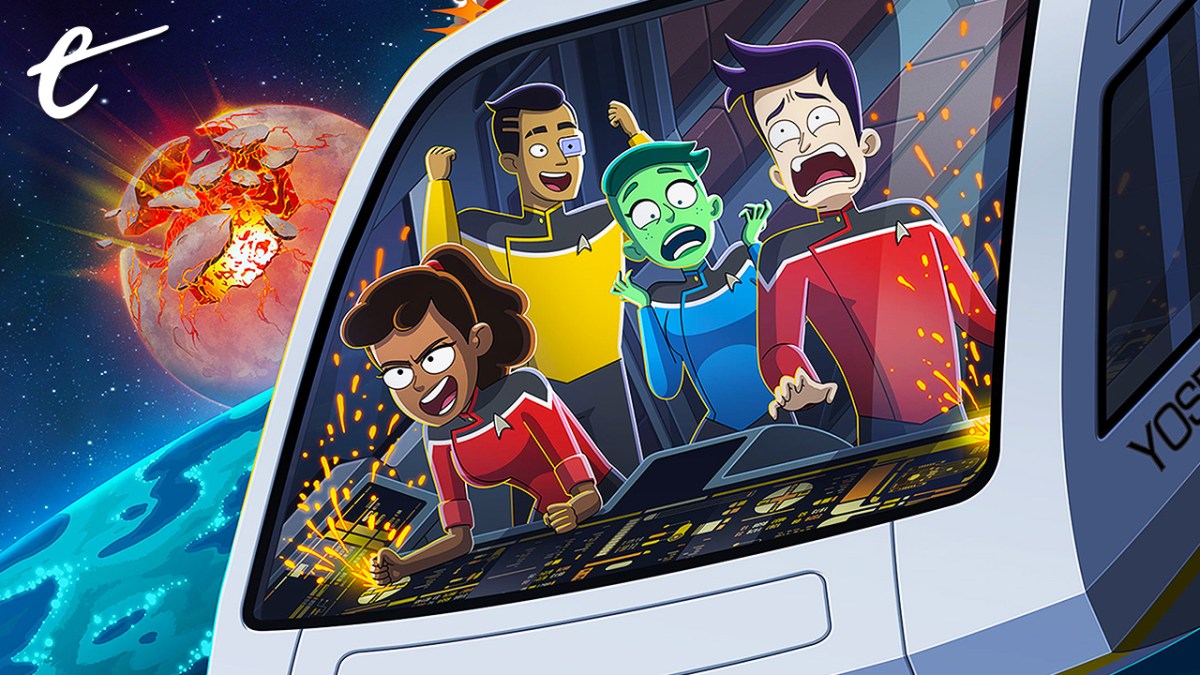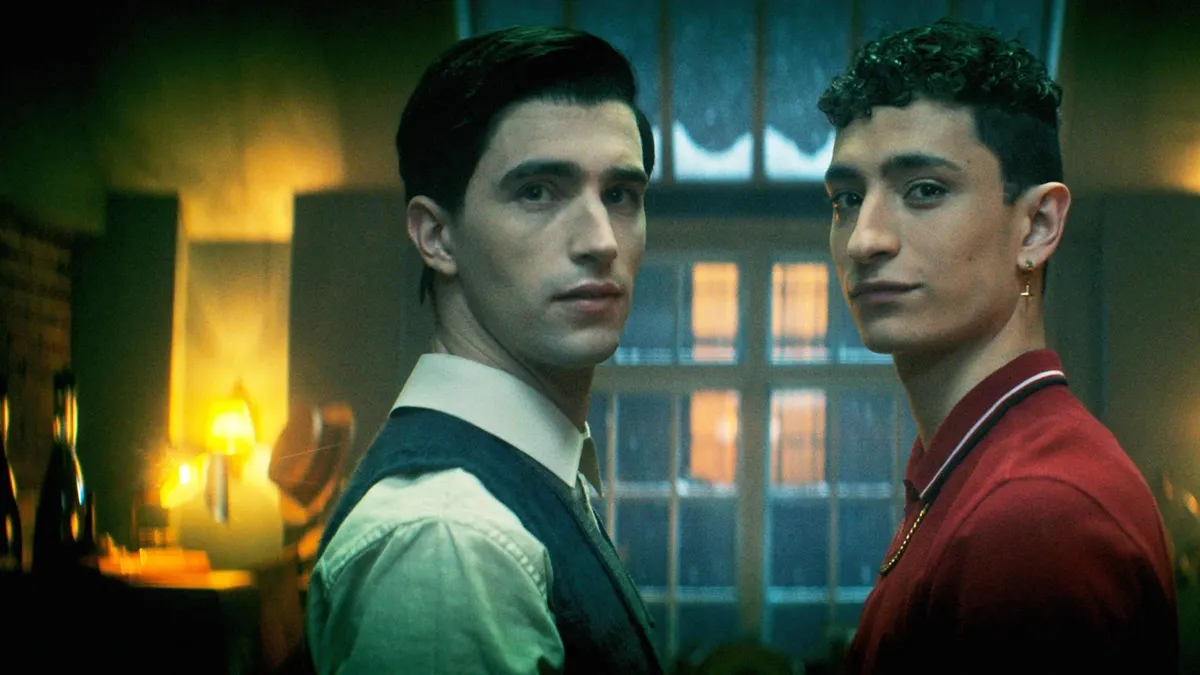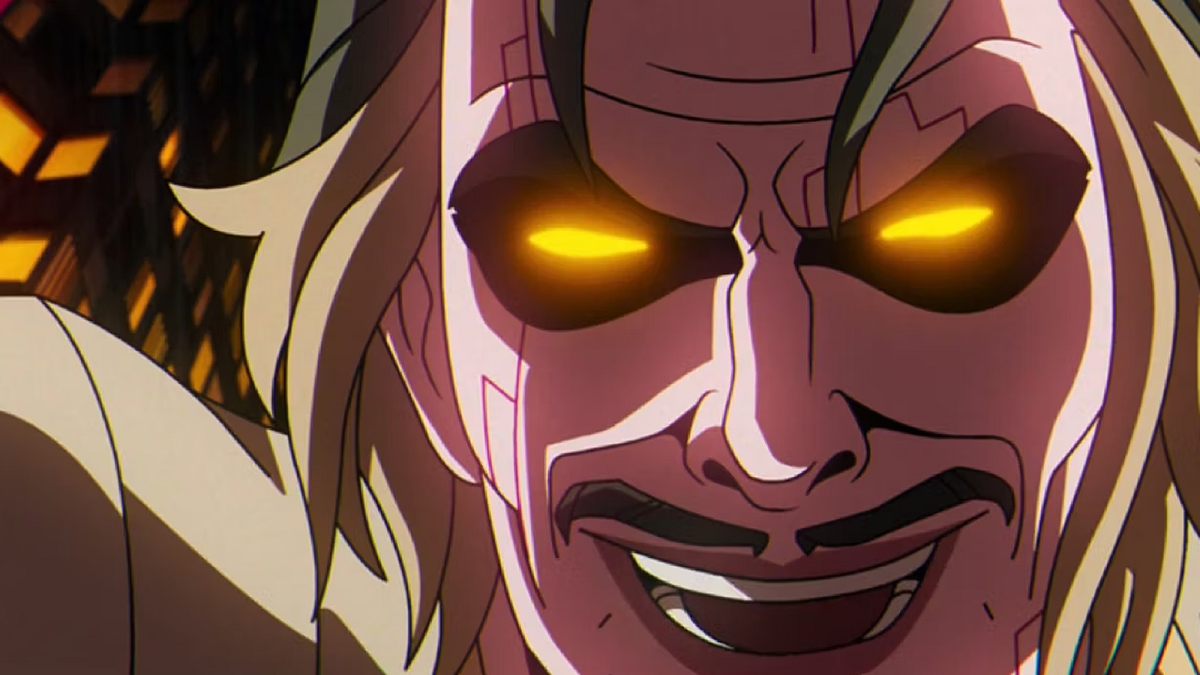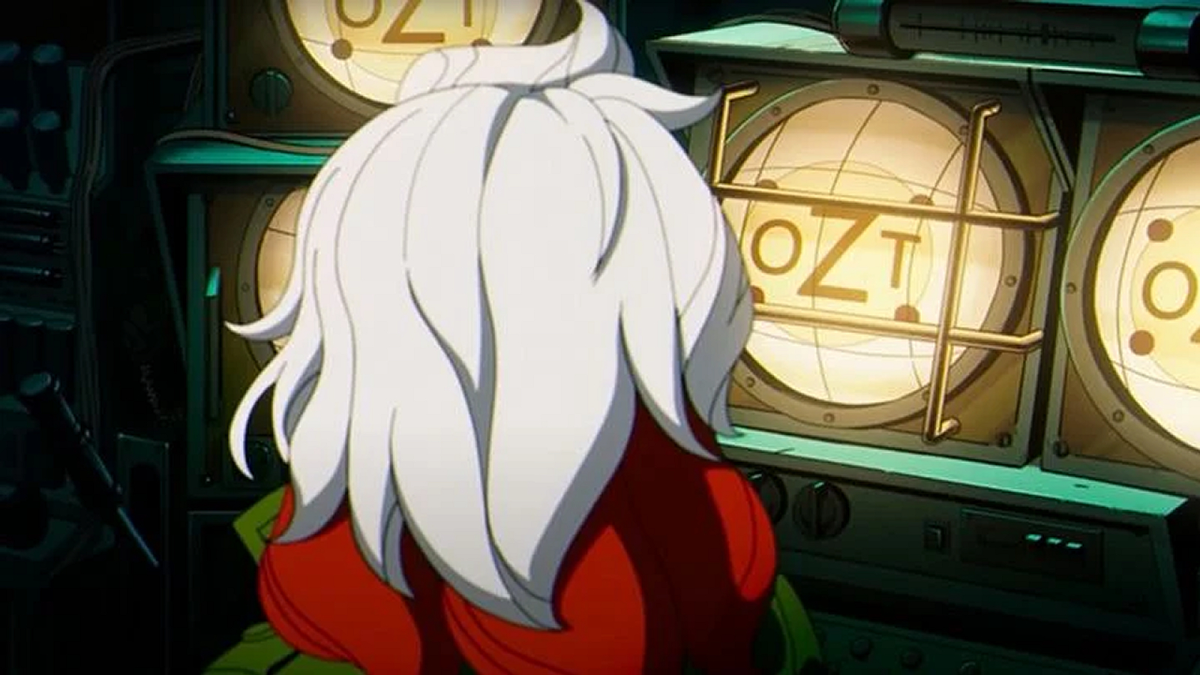This discussion and review contains spoilers for the Star Trek: Lower Decks season 4 premier, “Twovix,” streaming now on Paramount+.
On the surface, “Twovix” is a standard example of Star Trek: Lower Decks’ nostalgic impulses — a collection of familiar Star Trek iconography mashed together with a great deal of affection. However, there is something more interesting bubbling beneath the surface of the fourth season premiere.
Most obviously, “Twovix” is a love letter to Star Trek: Voyager. More than that, it has a lot to say about the larger Star Trek franchise’s evolving relationship to that spin-off. Voyager was a controversial and divisive Star Trek show. On broadcast, it was seen as the less ambitious and less compelling sibling to both Star Trek: The Next Generation and Star Trek: Deep Space Nine. The show had a compelling premise, focusing on a Starfleet ship stranded 70,000 lightyears from home, but it rarely delivered on that potential.
During the show’s initial run, critic Jamahl Epsicokhan lamented “watching the original Voyager ideology disintegrate through two disappointing seasons followed by a wandering third.” Veteran Star Trek critic Michelle Erica Green closed out her initial reviews of Voyager with the biting accusation, “There’s no yearning for exploration, no willingness to sacrifice for the greater good. Voyager is not real Star Trek.”
Epsicokhan and Green were not outliers. They remain perhaps the definitive reviewers of that era of Star Trek, and their writing reflected the general tone of the coverage of Voyager. Even Voyager actor Robert Beltran described the show as “a disappointment” in coverage of the finale. Following on from the massive success of The Next Generation, Voyager overlapped with a period of sharp decline for the ratings and cultural cachet of the larger Star Trek franchise.
Voyager also arrived at a time when fandom was turning increasingly hostile to that iteration of the franchise, perhaps typified by the series of meanspirited Adventures of Berman & Braga “parodies” written and shared online. Lower Decks is undoubtedly keenly aware of this context. After all, “Twofix” opens with a joke about Boimler (Jack Quaid) being assigned to “holodeck waste removal,” an allusion to the infamous Star Trek web essay The Life and Times of a Holodeck Janitor.

L-R Noel Wells as Ensign Tendi, Gabrielle Ruiz as TLyn, Tawny Newsome as Ensign Beckett Mariner and Jack Quaid as Ensign Brad Boimler appearing in episode 1, season 4 of Lower Decks streaming on Paramount+, 2023. Photo Credit: Paramount+
Time heals all wounds. Voyager has been subject to a reappraisal among Star Trek fans. Writing at RogerEbert in June 2013, Ian Grey called it “the Trekkiest Trek of all.” When Netflix announced its ten most popular Star Trek episodes in September 2017, six of the ten slots went to Voyager. (The other four went to The Next Generation.) When StarTrek.com ran a series of fan polls in 2012, fans declared that Voyager had the best first season and the best opening titles, that it should be the next movie franchise, and should be remastered for blu-ray ahead of Deep Space Nine.
Even looking at the slate of Star Trek programming on Paramount+, there is an obvious nostalgia for Voyager. Voyager’s Seven of Nine (Jeri Ryan) was a regular cast member on all three seasons of Star Trek: Picard, before most of the cast of The Next Generation joined the show. Star Trek: Prodigy is a loose sequel series to Voyager, featuring a holographic representation of Kathryn Janeway (Kate Mulgrew) as a regular character and a recurring role for Chakotay (Robert Beltran). This is, to put it mildly, more love than either Deep Space Nine or Star Trek: Enterprise have received.
As such, the basic premise of “Twovix” doesn’t seem absurd. It seems entirely plausible that Starfleet would turn Voyager into a museum exhibit. It doesn’t seem unreasonable for Beljo Treacle (Andy Richter) to describe Voyager as “the most beautiful work of art in Starfleet history.” It is very obvious that “Twovix” has a lot of affection for Voyager. The episode’s animated backgrounds look gorgeous, a love letter to Voyager’s production and set design. It is beautiful to see it rendered in animation.
However, to the episode’s credit, writer and showrunner Mike McMahan isn’t just invoking empty nostalgia. As a “curator and historian,” Treacle is framed as an obsessive and possessive fan, one worried about leaving fingerprints on his model starship. He boasts of the mannequin in “a mission-worn uniform.” He warns the Cerritos staff, “My legacy depends on everything making it to Earth in pristine condition.” He sternly insists, “Don’t touch anything.”
As imagined by Treacle, the Voyager museum is a lifeless experience. It is all velvet ropes and information panels, exhibits, and replicas. Everything has its place. It recalls the curative fandom that defined so much of the third season of Picard, most obviously in episodes like “The Bounty.” Everything is sealed in plastic in mint condition, restored like the bridge of the Enterprise in “Vox.” To its credit, Lower Decks has little patience for this approach. Toys are meant to be played with.
Naturally, “Twovix” finds the Lower Decks cast making quite a mess of Voyager. By the end of the episode, the ship is covered in sticky green alien gunk and overflowing with cheese. “We did it!” Boimler screams in triumph. “We broke Voyager!” If this is what Star Trek is to be — a franchise largely about throwing existing toys together in the hopes of evoking the audience’s memory of some distant childhood — then it should at least crash those toys into one another with passion and vigor.

Episode 1, season 4 of Lower Decks streaming on Paramount+, 2023. Photo Credit: Paramount+
More than that, McMahan very pointedly draws from Voyager episodes like “Learning Curve,” “Threshold,” “The Thaw,” “Macrocosm,” “Bride of Chaotica!,” and “Fair Haven.” As Boimler declares, “These are like Voy’s deepest cuts!” Tellingly, many of these were divisive and controversial episodes. In particular, “Threshold” has been named the single worst Voyager episode by sites like Den of Geek and Gizmodo. Making “Threshold” part of a nostalgic celebration of Voyager is a bold choice, even before the Salamanders sit in the captain’s chair.
As such, “Twovix” isn’t celebrating Voyager as it is remembered. It isn’t recreating the imagined perfect version of the show that exists in the heads of so many modern fans. It doesn’t evoke the show at its best. This is a very different sort of nostalgia than that regularly employed by Picard or Star Trek: Strange New Worlds. Instead, “Twovix” grapples with Voyager as it actually was. As Commander Ransom (Jerry O’Connell) notes when “the Neelix Cheese” comes up, “It’s Voyager. Shit got freaky.”
Voyager was a pulpy show. It was often a trashy show. It was frequently terrible. It regularly rejected any sense of logic, whether internal or external. Lower Decks argues, quite rightly, that loving Voyager should mean loving the show not despite these attributes, but because of them. In “Encounter at Farpoint,” Jean-Luc Picard (Patrick Stewart) mused, “If we’re going to be damned, let’s be damned for what we really are.” The same is surely true of being loved.
This is astute, a reminder that many Star Trek fans don’t see the franchise as it actually is. Instead, they remember it as they would want it to be. “Twovix” embraces Voyager for what it actually was, rather than some alternative version. “Are you sure this is going to work?” Boimler asks Rutherford (Eugene Cordero) as they set their final plan in motion, using the cheese from “Learning Curve.” Rutherford replies, “No, but it feels like a kooky Voyager solution, so it’s worth a try.”
With this in mind, it’s also notable that “Twovix” isn’t especially starry-eyed when it comes to the episode’s most obvious influence, “Tuvix.” That episode, in which Tuvok (Tim Russ) and Neelix (Ethan Phillips) are combined into a third unique entity (Tom Wright), remains divisive among fans for Janeway’s decision to effectively “kill” that third sentient person to restore Tuvok and Neelix. It was subject of much debate, for example, in TrekToday’s post-finale collection of articles analyzing Janeway’s conduct, The Court Martial of Captain Janeway.
When a freak accident combines T’Ana (Gillian Vigman) and Billups (Paul Scheer) in “Twovix”, the crew are horrified to discover how Janeway solved that problem. “She knows Janeway straight-up murdered Tuvix, right?” Mariner (Tawny Newsome) asks when Captain Freeman (Dawnn Lewis) requests the logs from “Tuvix.” When informed of Janeway’s solution, Shaxs (Fred Tatasciore) gasps, “Holy shit! Janeway didn’t mess around.” “Twovix” is not a hagiography for Janeway or for Voyager.
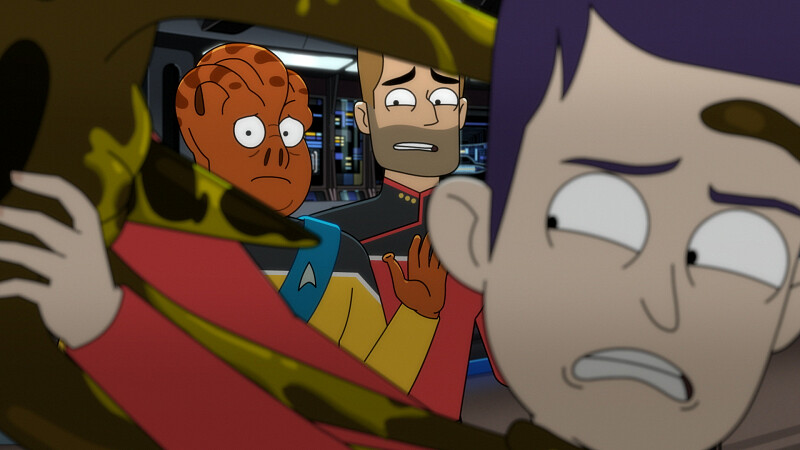
L-R Carl Tart as Lieutenant Kayhon, Jerry O’Connell as Commander Jack Random, Jack Quaid as Ensign Brad Boimler appearing in episode 1, season 4 of Lower Decks streaming on Paramount+, 2023. Photo Credit: Paramount+
There is also a sense in which “Twovix” isn’t entirely about Voyager. As a season premier, it is also a show about Lower Decks. Watching the episode, it seems like McMahan is using Voyager as a framework to have a conversation about Lower Decks itself. This is most obvious in the way that the episode treats Voyager, eschewing the uncomfortable reverence that Picard and Strange New Worlds has for the Berman era. Lower Decks is not afraid to leave its mark on Voyager.
This is obvious in the subplot focusing on T’illups, which avoids rehashing the plot beats of “Tuvix,” as Strange New Worlds often does in episodes like “Children of the Comet” or “Memento Mori.” Instead, reflecting his experience as a writer on Rick & Morty, McMahan escalates the plot to the point of absurdity. The concept is pushed past its logical extreme, characters combined until the bulk of the ship’s crew is just “one big Tuvix-y meatball,” “a non-sentient blob of meat.” Lower Decks takes the basic plot idea and then does its own thing.
Recently, there has been a conscious effort to assert the validity of Lower Decks alongside the live action shows. The third season finale, “The Stars at Night,” was a celebration of the show’s internal continuity. Between seasons, Boimler and Mariner appeared in live action in “Those Old Scientists,” a formally experimental episode of Strange New Worlds. This year’s Star Trek day will specifically celebrate animated Star Trek and will feature theatrical screenings of Lower Decks episodes.
After all, Lower Decks has been subject all manner of criticisms from fans. (“Is this what Star Trek has become?,” to quote one memetic melodramatic complaint.) Not only is Lower Decks a comedy, it is also an animated series, and the last animated Star Trek show faced similar challenges. So it feels fitting that “Twovix” ends with Boimler and Rutherford immortalized in the museum itself. They are part of the history of Voyager, much like Lower Decks is part of the history of Star Trek.
“Twovix” is about the shifting perception of Voyager, how yesterday’s trash is tomorrow’s treasure. It also makes a statement about Lower Decks. By placing the shows alongside one another, McMahan illustrates that the gap between the two is not as extreme as it might seem, it’s a matter of degrees. Star Trek has always been ridiculous and goofy, “freaky” and “kooky.” More fundamentally, “Twovix” is a reminder that what is often dismissed as “not real Star Trek” often ends up in museums.

